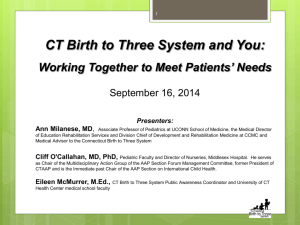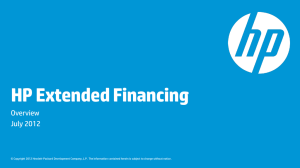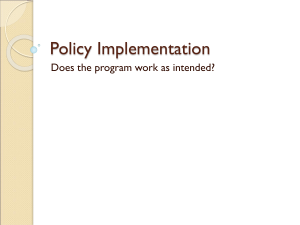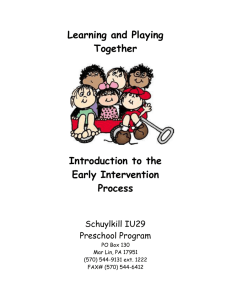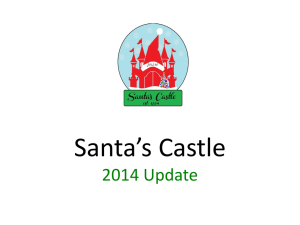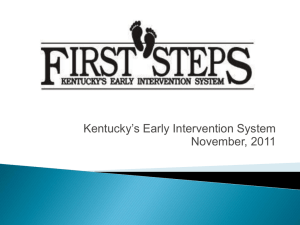The Connecticut Birth to Three System
advertisement
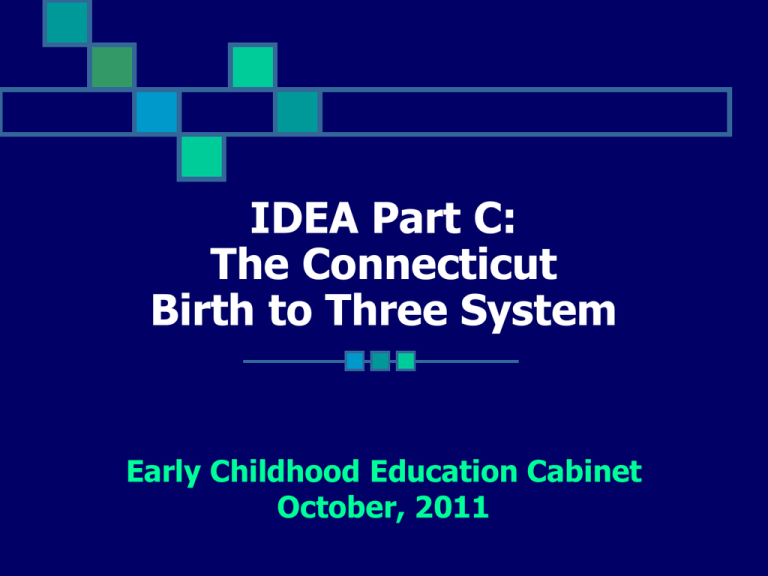
IDEA Part C: The Connecticut Birth to Three System Early Childhood Education Cabinet October, 2011 What IS IDEA Part C? Individuals with Disabilities Education Act Part A – General Provisions Part B – Special Education ages 3-21 Part C – Infants and Toddlers with Disabilities Part D – National Activities to Improve Education of Children with Disabilities (includes Parent Training and Information Centers) IDEA Part C encourages, but does not require, states to participate. All 50 states do currently. Annual federal funding based on state population ($4M for CT) requires an annual application explaining how the state meets each required component of the law and assuring the U.S. Dept. of Education that the state’s policies are in full compliance with the IDEA. Required Components •Designate a lead agency •Have an Interagency Coordinating Council •Assign financial responsibility, pay for services •Describe the system and services (including services in natural environments) •Policy on use of funds •Referral and eligibility policies •Transition policies •Public Participation in policies •Coordinate with Head Start, Early HS, other ECE programs State Assurances •Equitable access •Expenditure of funds •Payor of last resort •Control of funds and property •Reports and records •Prohibition against supplanting •Restricted indirect rate •Fiscal controls •Traditionally underserved groups The core mission of the Connecticut Birth to Three System is: to strengthen the capacity of families to meet the developmental and health-related needs of their infants and toddlers with disabilities or delays AND The core mission of the Connecticut Birth to Three System is: to ensure equal access to a coordinated program of comprehensive services and supports. What We Do Referrals Eligible Children Early Intervention Services Referrals FY11 referrals – 8,603 10000 8000 6000 4000 2000 0 1996 1999 2002 2005 2008 2011 The Connecticut birthrate has decreased since 1995 2010 – 37,446 Provisional data from DPH 46000 44000 42000 40000 38000 36000 34000 32000 1995 1997 1999 2001 2003 Births 2005 2007 2009 The majority of referrals are directly from families FY11Referrals State Agencies Health Care Providers Families More children are referred after age two Age at Referral Birth – 12 months 12 – 24 months 24-35 months Percentage 22% 38% 40% 65% of all referrals are boys Which children are eligible? IDEA Part C requires serving: 1. children with medical conditions expected to lead to a developmental delay and 2. children who have a developmental delay. The definition of developmental delay and the choice of conditions is at the state’s discretion. Which children are eligible? The IDEA also says that: Children at environmental risk for delay MAY be eligible if the state wants to include that population in its policies and application. Connecticut has never served children who are at environmental risk for developmental delay in Part C. Which children are eligible? Connecticut adopted a narrow definition of developmental delay in 1993: A child must demonstrate a delay of 2 standard deviations below the mean in at least one area of development or 1.5 SD below the mean in two or more areas Which children are eligible? Today, about 60% of the children evaluated each year are eligible. 10% due to diagnosed conditions (including extremely low birth weight below 1000g or gestational ages of 28 weeks or less). 90% due to developmental delay Birth Cohort Data Birth Year Referred % Eligible % 2000 6147 14% 4293 10% 2001 6681 16% 4580 11% 2002 6634 16% 4453 11% 2003 6826 16% 4238 10% 2004 7146 17% 4169 10% 2005 7543 18% 4293 10% 2006 7759 19% 4599 11% 2007 7645 19% 4276 10% Who provides the services? 44 local programs •32 general • 9 autism-specific • 3 deaf/hard-of-hearing specific At least two general programs serve each town. At least one autismspecific program serves each town. All three deaf/hard-of-hearing programs are statewide Who provides the services? Programs are operated by a variety of host agencies: 1 state-operated by DDS 2 LEAs 5 RESCs For profits Not-for-profits Who provides the services? In early October, three RFPs were issued for the three types of programs. All current contracts end 6/30/12 and new contractors will be selected from among the proposals received. DDS is phasing out its state-operated program. Who provides the services? Discipline # and % receiving Speech and Language Pathologist Special Educator Occupational Therapist Physical Therapist Early Intervention Associate or Assistant Social Worker Board Certified Behavior Analyst or Associate Analyst Audiologist Nutritionist Occupational Therapy Assistant (COTA) Nurse Psychologist Physical Therapy Assistant Family Therapist/Professional Counselor 5,676 65% 4,337 49% 2,952 34% 2,823 32% 2,805 32% 665 8% 502 6% 401 5% 175 2% 149 2% 73 1% 68 >1% 65 >1% 24 >1% How much does it cost? FY11 Expenditures: $50M State Federal Insurance Fees $41M Reduced by $9.7M in Medicaid reimbursements to General Fund How much does it cost? Per child gross cost in a general program is $8356 per year for most children. Average hours of direct services delivered per month is 4.2. For children with autism, the gross cost per year averages $30,000. Average hours of direct services delivered per month is 46. How Well Do We Do It? 99.9% of children are evaluated and service plans are written within 45 days of referral 99% of services are delivered in natural environments (home or child care) 98% of transition conferences are timely CT Part C has been determined to “meet requirements” of IDEA five years in a row Is Anyone Better Off? Families are surveyed annually to determine whether Birth to Three helped them: Know their rights, 88% Effectively communicate their children’s needs, 86% and, most importantly, Help their children develop and learn 95% Is Anyone Better Off? 9% of children exiting (about 450 each year) are no longer in need of services 2100 children transition to preschool special education services (44% of all children exiting and 81% of those referred to their school districts) By Kindergarten age, only 50% of children who ever received Birth to Three services are enrolled in special education. Tracked by SASID from B-3 to SDE data. Is Anyone Better Off? We assess children entering and exiting the program to determine progress in: Positive social/emotional skills; Acquiring and using knowledge and skills (includes communication); and Using appropriate behaviors to meet their needs Is Anyone Better Off? Skill Area Caught Up Reduced the gap Social/emotional 51% 83% Knowledge and skills 55% 83% Appropriate behaviors 63% 89% We can’t do this without our partners DCF – agreement on CAPTA referrals DSS – co-fund Child Development Infoline Office with the Children’s Trust Fund; Bill Medicaid SDE – notification to districts, data sharing, co-fund training and newsletter DPH – finding preemies and children with hearing loss, home visiting advisory Next Up Legislative proposal to combine DPH home visiting advisory council, Nurturing Families Network advisory council, and Birth to Three Interagency Coordinating Council November monitoring visit by OSEP Monitor FY12/13 budget since budget was reduced in anticipation of more insurance revenue May need to write a Medicaid 1915i waiver

